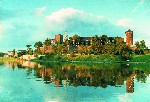Conference Banquet
 The official Conference Banquet took place in the Wieliczka Salt Mine,
in the "Warszawa" Salt Chamber, more than 100 m below the ground level.
The official Conference Banquet took place in the Wieliczka Salt Mine,
in the "Warszawa" Salt Chamber, more than 100 m below the ground level.
The Conference Social Programme - General Information
Detailed Tourist and Musical Evening Programme
Post Conference Tours
The Conference
social programme was addressed to the participants and the accompanying persons. It included:
The Musical Evening was arranged on Wednesday, June 27. It took place in restaurants, several music halls and churches.
Dinner in a restaurant with Jewish music
Dinner in a restaurant with Polish folk music
Concert in the Premonstratensian Sisters Cloister
Dinner for the members of IACM/ECCOMAS Advisory Committee,
International Scientific Committee and all the In-vited Speakers with
accompanying persons,
in a restaurant with old Polish music
(dinner offered by the Organizing Committee)
Conference Banquet The official Conference Banquet took place in the Wieliczka Salt Mine,
in the "Warszawa" Salt Chamber, more than 100 m below the ground level.
The official Conference Banquet took place in the Wieliczka Salt Mine,
in the "Warszawa" Salt Chamber, more than 100 m below the ground level.
 While taking a walking tour around the biggest European Main Market Square you will be able to admire the wonderful Our Lady Church with the famous altar by Veit Stoss, the unique Cloth Hall, the 600 year-old Collegium Maius of the Jagiellonian University, some gothic and baroque churches and a rich collection of paintings and objects of art housed by the Czartoryski Museum.
While taking a walking tour around the biggest European Main Market Square you will be able to admire the wonderful Our Lady Church with the famous altar by Veit Stoss, the unique Cloth Hall, the 600 year-old Collegium Maius of the Jagiellonian University, some gothic and baroque churches and a rich collection of paintings and objects of art housed by the Czartoryski Museum.
The Wawel Hill The Royal Castle, one of the most representative museum in Poland, is famous not only for its Renaissance courtyard but also for Flemish arras tapestries. The Wawel Cathedral, where the Pope John Paul II was a Bishop for many years, is worth visiting for its outstanding architecture. It is also the acropolis with tombs of the Polish kings, poets and national leaders.
The Royal Castle, one of the most representative museum in Poland, is famous not only for its Renaissance courtyard but also for Flemish arras tapestries. The Wawel Cathedral, where the Pope John Paul II was a Bishop for many years, is worth visiting for its outstanding architecture. It is also the acropolis with tombs of the Polish kings, poets and national leaders.
The Wieliczka Salt Mine
 The Mine (12 km East of Cracow), which dates back to the 13th century, is the world famous monument of man's activity in the field of technology and arts. The three-hour, underground visit shows the beauty of salt and other minerals in the surprising surrounding of natural and human works.
The Mine (12 km East of Cracow), which dates back to the 13th century, is the world famous monument of man's activity in the field of technology and arts. The three-hour, underground visit shows the beauty of salt and other minerals in the surprising surrounding of natural and human works.
Auschwitz